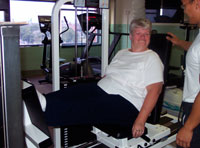By NCHPAD

Physical activity has been shown to improve cardiovascular and muscular fitness, mental health, and the ability to perform activities of daily living. And though I hope it’s of no surprise, this holds true for everyone.
For the most part, the guidelines for people with disabilities are not much different from the guidelines designated for “active” adults. The main difference seems to be the incorporation of the phrase “who are able to” into the specific recommendations as well as the removal of the suggestion that individuals should continue to increase or progress activity to reap even further health benefits (i.e. “the more the better”). There is also an additional recommendation for people with disabilities to consult a health-care provider about the amounts and types of physical activity that are appropriate for their abilities.
So let’s break this down:
- Physical activity provides the same benefits to everyone.
- Everyone should work toward performing the same amount and types of physical activity on a daily basis.
- BUT, if you have a disability, you should find out how to do so.
Sounds simple.
But how do you find out how and where to exercise if (for example) you were born with spina bifida and the only person that you have ever seen for exercise (physical therapy) is at the rehabilitation hospital 2 hours away? PLUS, you use crutches to ambulate to work so don’t have enough energy reserve to take additional walks around your neighborhood but there are no curb cuts for using your wheelchair on the sidewalks. PLUS, your local gym doesn’t have any upper body machines or staff members who seem comfortable with your disability. PLUS, you have trouble regulating your body temperature and are concerned that any exercise will exacerbate your spasticity or other neurological symptoms.
That doesn’t make it sound so easy, does it?
People with disabilities may find more difficulty than most in meeting the recommended Physical Activity Guidelines based on the barriers they face when seeking out physical activity. Barriers can be architectural (there is no curb cut), programmatic (chairs are not available in exercise classes), or attitudinal (assumptions based on a diagnosis or the use of an assistive device).
Studies show that physical activity can be done safely when the program is matched to an individual’s abilities. We all have different abilities, different strengths and weaknesses, different levels of activity, different needs, different interests, etc. As fitness professionals, we have the opportunity of a lifetime to provide a much needed and appreciated service to millions of people (with and without disabilities) by becoming trained, knowledgeable and willing to adapt activities to address society’s differences, regardless of the existence of medical diagnoses.
So what do we do now? Here are a few suggestions:
- Look at what the person can do, not their limitations.
- Seek training and educational opportunities.
- For example, there is a new specialty certification from the American College of Sports Medicine and the National Center on Physical Activity and Disability called a Certified Inclusive Fitness Trainer
- Expand your marketing. The world of disability is a large one, 54 million, and it is also a well connected. Often one member/client will mean many more to follow.
For more information about physical activity for people with disabilities, go to www.ncpad.org.
What else can fitness professionals do? What are you already doing?